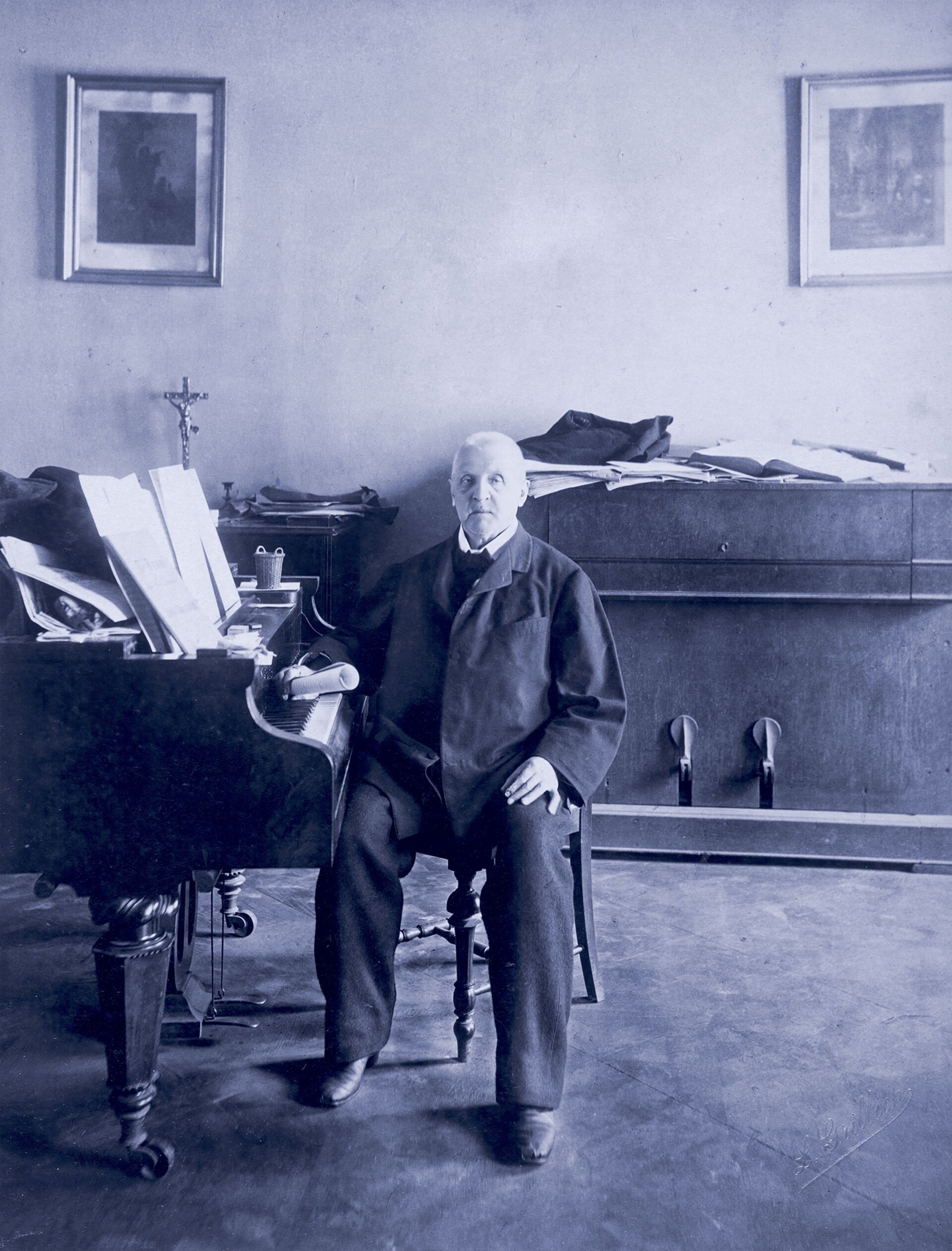Feierlich, Misterioso
By Harry Laventure
Solemnly, mysterious etch the brackets into which we are hemmed in the opening sears of the first movement. Violins buzz with the tremors of dust disturbed in the prelude of a tempest’s caprice, and call the calling of sombre fanfare. Thus the brass asserts itself above the tremolo in forceful simplicity, and therein the inscribed syllables of loft find their reciprocal: the nod of a bull before the altar’s slaughter. Forgive the Classicist his unimaginative vices, but there is something of Homeric grandeur in this sonic landscape. The twin rumble of drums are hammers to the battlelines, and we are sealed in amidst the scattered promises and declarations of an uncanny hero’s ambition. Our tension is permitted a woodwind reverie of gasping brevity, a bouquet of memories before commencement. We hear what it is to soar in the vignettes of a past well spent, spliced with shots of remorse too thrifty. Then comes the surge, at the mercy of a rolling wave’s architecture: from the raging torrent swells some dark god – the conductor himself? – and with it the orchestra is electrified into a monument of raw majesty, blasting thunderous bolts of assault on the ear in ruthless succession. Paralysis of megalophobia, to coin a phrase. Under these auspices does Bruckner begin his theological wrestling match: the unfinished Symphony No.9 in D minor.
Some forty-five minutes earlier, I had disembarked at Newcastle station. Abiding thematic etiquette, the fragrance of a fashion show induced hangover had left me feeling penitent. Indeed, advancing on the refractive armadillo of The Glasshouse at Gateshead by afternoon sunlight, I mused that perhaps this was the only way to appreciate a work written on the composer’s death bed. Macabre remarks aside, I had never visited the International Centre for Music; I was quite shocked to find such a titanic figure perched like an enormous silver hippopotamus enjoying a river tipple. Changing its name from The Sage in 2022, the £70,000,000 project was built in 2004, and houses a small rehearsal and performance space, a 450-seater, and a 1,700-capacity auditorium. The latter of these formed the arena for the afternoon’s concert – the third day of The Glasshouse’s Big Bruckner Weekend in celebration of his 200thbirthday.
A true centurion of the concert hall, my grandfather had attended all three days, witnessing the Royal Liverpool Philharmonic’s take on Bruckner’s 7th (“quirky”), the Hallé’s portrayal of his 8th (“breathtaking”), and the Royal Northern Sinfonia’s performance of his ‘Great’Mass No.3 (“quite staggeringly beautiful”), to name the party pieces. Whilst we enjoyed a sobering glass of elderflower, I surveyed the belly of this beast to the soundtrack of three of Bruckner’s motets, live. Bar the occasional jolt of ground coffee belted from its chamber, a reverential silence cascaded upon the open-plan café and restaurant as we were serenaded by the Royal Northern Sinfonia’s chorus. The acoustics cradled the gentle cadences of these chapel-sized blooms, and the delicate parhelia of technicolour lights above provided fitting aesthetic symmetry. It was moving in a soft way, and quite unlike the rip-roaring blasts of the symphony to come. A composer of measure, I chortled to myself.
On 4th September 1824, Anton Bruckner was born intothe Grimmly named Ansfelden, Linz-Land. A variation on a fairy-tale theme, he was the eldest of 11 childrenand the son of the village schoolmaster. Though the family’s poverty rendered a solely musical career untenable, his early years ran parallel to the lines of the stave – lessons in violin and the organ from his father set the tone for the man who would come to be known for his meticulous, obsessively-calibrated scores. Prior to this symphonic success, he trained as a schoolteacher, returning from positions at Windhaag and Kronstorf to the monastery where he had once played chorister: St. Florian’s. 1855 saw him grace the organ-pipes of Linz Cathedral, before spending the best part of a decade studying under Simon Sechter and Otto Kitzler. The latter of these two pedagogues would introduce Bruckner to his most profound musical influence and champion in Richard Wagner. By 1868, Bruckner had secured the position in the Viennese Conservatory previously held by Sechter, and had become court organist for Emperor Franz Joseph I. Then, and only then, could he turn his hands to composition.
Many biographers have gone to great lengths to demonstrate the peculiarities of this “late blooming”. Aged 38, Bruckner had already outlived Mozart and Mendelssohn’s entire careers before he put quill to stave– I daresay you can hear it. This procrastinated musical puberty meant a very choppy few years for the Austrian. His organ playing was unquestionably gifted, but his composition was the subject of frequent and vehement ridicule. Brahms would lambast his work as a toggle of‘symphonic boa-constrictors’, referring to the man himself as a drunkard and a ‘bumpkin’. Indeed, though Wagner considered him the finest symphonist since Beethoven, Bruckner’s 1877 premiere of the 3rdsymphony was such a catastrophe that most of his audience left before it had finished. As a man of perpetual low self-confidence and revision, he would go so far as to beg the emperor to prohibit the draconian critic Eduard Hanslick from writing about him. It was only twelve years before his death, upon the opening performance of his Symphony No.7 in E Major in Leipzig, that Bruckner would receive due applause for his work. The final nine years of his life would see him metronomically sway between grave illness and the attempted completion of his most grandiose aspirations yet in his Symphony No.9.
Feierlich, Misterioso. The existential sobriety of a pious man’s last musical musings is indeed enveloped in enigma. Even the famous dedication Dem Leiben Gott (To the Good Lord) is a matter of dispute, with some suggesting Bruckner’s doctor Richard Heller fabricated it. Quoted or not, it goes some way to connote the scale of this biblically infused colossus. Numerous writers (the present not exempt) have resorted to hyperbole to articulate the majestic physicality of the work. Graf would compare Bruckner to a medieval architect before a Gothic cathedral. The Glasshouse’s website calls him ‘musical marmite’, with the tagline ‘Bold. Brassy. More peaks than the highlands’. Perhaps Douglas Kennedy’s Leaving the World puts it best: ‘the search for the divine amidst the whirligig of the quotidian; the notion that there are large, ethereal forces at work in the universe’.Between belches of dissonance and swooning passages of beauty, the composer’s behemoth embraces every kaleidoscopic slide of life as the man in fever clings to the bedsheets with atavistic desperation.
And so, it fell to the Scottish Symphony Orchestra to inflate this piece to popping point. I took my seat, awkwardly parcelled the programme below my chair, and performed the stand-up stand-down routine as last-minuters scuttled past me. Settled, the doors locked us in. The young iridule Alpesh Chauhan strutted as a gladiator to his conductor’s perch. Thus, the ring completes. I have gone to some lengths to describe the scintillating opening of the first movement, triumphant and commanding with phrases of delicacy. In many ways, this is a fitting synecdoche for the whole chapter. There are groans of elephantine proportion, and cadences like the exhalation of a dandelion on a clement gust. Rapid, tumbling passages expel us from paradise, before peacefully curious, dainty perambulations hold our hands with glee. The movement finishes as it started, as a towering pillar that confronts even the casual listener: the aggressive finger of accusation to the heavens seen in a high church spire. The Scherzo of the second movement is crashing and dynamic, tying us to the back of a chariot that drags us through wastelands by night, by way of Bruckner’s own katabasis. Bewegt, Lebhaft. Emotional and lively, it attacks the ear with vermiculite aggression, and wouldn’t be out of place replacing Williams’ famous Imperial March. Finally, the Adagio is Bruckner’s ‘farewell to life’. If the battle has been lost and won, the bittersweet third movement is reflective and elegiac, at once a lament and a celebration of achievement and decay. Langsam, Feierlich. We start as we begin, but emerge changed utterly: solemnly, but slowly. Mystery gives way to clarity and consideration, but the conclusions are of magnificent scale and effect. Unsurprisingly, there is Wagnerian climax in the spine-tingling ‘cathedral of sound’, and we are left in the cosy fallout of a truly nuclear finale. If this sounds excessive, it is. The SSO were sublime, and Flora Willson’s review was absolutely right to praise Chauhan as a charismatic and balletic conductor, at once channeling the energy of this almighty work and bridling the tension necessary to execute it. I think I heard more than one exasperated “blimey” as I walked out, bereft.
Given this sense of closure, it is perhaps even more bizarre to consider that this was not the intended ending. As Bruckner passed on to meet his maker, the fourth movement remained unfinished. His doctor Heller claimed that ‘he had drawn up a contract with his ‘dear Lord’’ – I wonder if it was fulfilled thus. Many have edited, revised, and ornamented the final movement in vain attempts to give the piece its full glory. But to my mind, performing it as is feels overwhelming enough, only just balanced. For all his division and derision, a word that doesn’t come up enough when discussing Bruckner is poise. Whether he pushes or pulls us, toys with our expectations or fulfils them, there is an innate sense of pacing that maturely pulses throughout – a sign of his age, possibly.
Bruckner’s reception through the years has been unorthodox to say the least. His influence is hard to express, but tangible. Occupying a liminal space between Wagner and Mahler, it is unsurprising that cinematic parallels are often drawn in the epic scale of his symphonies. This occurs in translation and paraphrase: as Bergman adopted the Scherzo of Symphony No.9 in Saraband, there is certainly more than a smattering of the Jaws bass in the opening minutes of the Adagio. Some have even suggested an impression on contemporary music: take to minute 3.05 of the 2005 Munchner Philharmoniker/Christian ThielemannSymphony No.5 in B flat Major, and try not to detect The White Stripes’ painfully omnipresent Seven Nation Army riff.
Influence aside, Bruckner has been the victim of more than one biographical embellishment or rumour through the years. We have already seen the potential tampering of his doctor, Richard Heller, in the alterations to his final work. Morbid oddities are a weed-like motif throughout his other biographies. The mammoth ninevolume work of Auer and Göllerich (1922-37) mentions a compulsion to count, claiming Bruckner was addicted to numbering everything from windows, to steps, to the bars of his scores. We are also told of nine documented proposals to women much younger than him (all rejected), and a page in his notebook reserved for those whom he had taken a fancy to. He allegedly planned his funeral with fastidious acumen, and cherished a picture of his mother on her death bed. Once more, Butt names testimonies that Bruckner had ‘fingered and kissed the skulls of Beethoven and Schubert’. There is no denying that Bruckner was a most peculiar man.
And yet, as with all lives of the artists, we must be on our guard to writers’ attempts to make the private moments of great creators and pioneers live up to the scale of their outward inventiveness. In many ways, we probably ought to be thankful for these attention stunts: in the 1927 printing of Grove’s Dictionary of Music and Musicians, Anton Bruckner receives no more than a singular paragraph, deemed too redolent of Wagner for due time and effort. We are on the correct trajectory to rectify this misdemeanour. Although we may never know the man, the panegyrics of our eyes will always harmonise with his work. The Glasshouse’s Big Bruckner Weekend did a stupendous job of facilitating that. The exhibition Bruckner, the Pious Revolutionary at the Austrian National Library’s State Hall will hopefully amplify awareness further. Only time will tell whether we are capable of more perseverant praise than sitting up and listening at a landmark like his 200thbirthday. To plagiarise a toast, perhaps Ludwig Speidel put it best: ‘it is no common mortal who speaks to us in this music’. For all his solemnity and mystery, let us tip our hats Bruckner’s way.



